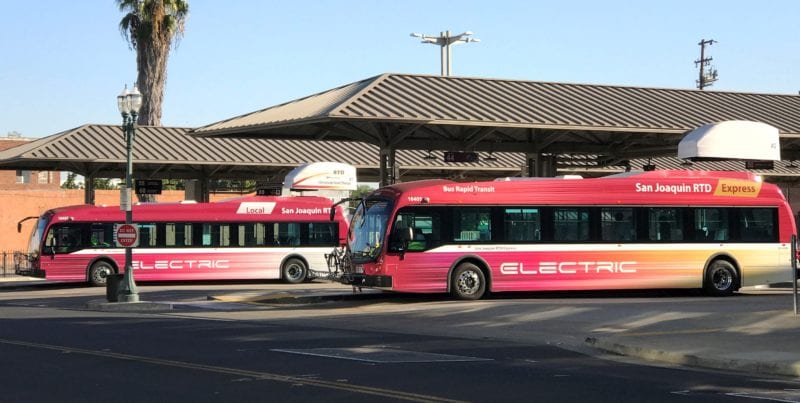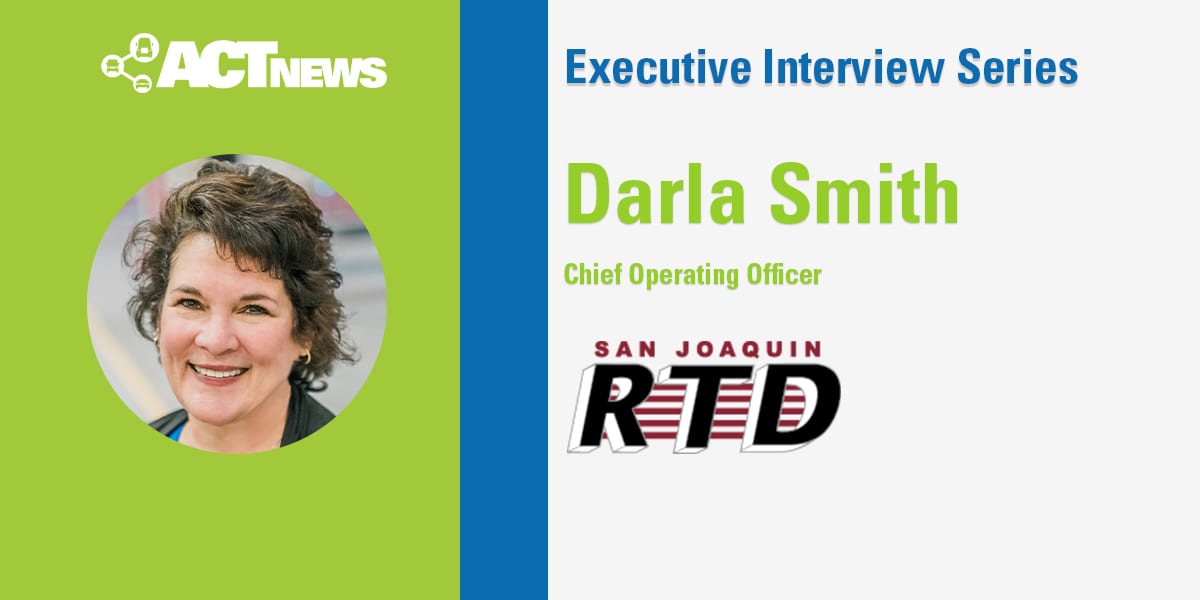An ACT News Executive Interview with Darla Smith, chief operating officer of the San Joaquin Regional Transit District to hear how they lowered charging costs by partnering with PG&E.
San Joaquin Regional Transit District (RTD) was an early adopter of bus electrification. When they decided to pilot electric buses in 2013, RTD was the first transit agency in Northern California to introduce a 100% battery-electric bus into service. Supported with a California Energy Commission grant and a partnership with Proterra, RTD broke the mold on clean-tech public transit. In 2016, the agency took another big leap by creating the nation’s first all-electric-bus rapid transit route, with the vision to transition the fleet that operates in the Stockton metropolitan area to 100% zero emission by 2025.
RTD is the regional transit provider for San Joaquin County, serving the region with intercity, interregional, and rural transit services. RTD serves more than 1,400 square miles, which includes seven cities and a large agricultural area. Because the region is so large and diverse, RTD provides many types of public and mobility service. RTD’s vision is to be the transportation service of choice for the residents they serve.
ACT News caught up with Darla to learn how partnering with PG&E, their electric utility, and the electric bus manufacturer Proterra have been key to their continued progress in converting the fleet to battery-electric buses.
ACT News: What are some of the benefits of EVs and lessons learned on the journey to a battery-electric bus fleet?
Darla Smith: The biggest benefit is that with the deployment of each battery-electric bus we are improving the environment in San Joaquin county. We are committed to a sustainable business model that includes environmental and fiscal responsibility. This includes making sure we are creating a safe and responsible environment for our community, our customers, and our employees.

Another benefit is being able to participate in the low carbon fuel standard (LCFS) program in California. Because RTD owns the electric chargers providing electricity as a fuel for our buses, we can generate LCFS credits. These credits are a revenue source for RTD. PG&E is our partner in this program, they helped us set up dedicated meters to monitor and record the amount of electricity used for fleet fueling, so we can accurately track the credits we earn.
The most valuable lesson learned was understanding how billing for electric charging works. We learned how to incorporate the time-of-use rate tiers and how it affects charging cycles.
The partnerships with PG&E and Proterra have been key to RTD’s success with electrification. We’ve also learned the value of federal and state incentives, which help fund our transition to EVs.
ACT News: How has the partnership with PG&E helped to prepare RTD for its goal for the intra-city Stockton Metropolitan Area to operate 100% zero-emission electric buses by 2025?
Darla Smith: PG&E and RTD are definitely partners on this journey to a battery-electric bus fleet. The challenges we face are the infrastructure and power requirements for charging, as well as monitoring the cost of electricity. The electric infrastructure may need to be upgraded for the additional depot chargers. This requires advanced planning and coordination with PG&E, to make sure they can meet our power requirements, which will be massive. There may be a need for grid upgrades to support the energy load our fleet will require, especially when our goal is to deploy 100% zero emission buses by 2025. Long term budget planning and site evaluation for future infrastructure is critical for us to move forward.
“PG&E is a partner on this journey to a battery-electric bus fleet. They help with site evaluation for future infrastructure.”
ACT News: How has the new Business EV rate affected your electrification plan?
Darla Smith: When PG&E introduced the Business EV (BEV) rate plan in 2020, it significantly decreased the cost to charge the buses and improved operating costs. The first month we enrolled in the BEV rate plans, we saw cost savings totaling nearly $15,000. Overall, the fleet reduced the fuel cost per mile from $2.31 to $0.68 with the BEV rate plan.
The BEV rate plan offers two subscription rates, which combine a monthly subscription charge based on energy usage and a time-of-use rate. PG&E helped us determine the best rate plan to keep fuel costs low.
ACT News: How important is it to partner with the local utility and vehicle/infrastructure OEMs when taking on an electrification project?
Darla Smith: These partnerships are critical. RTD worked with PG&E to determine what combination of depot and overhead charging would optimize charging schedules at three separate locations for the fleet we have today. This meant we had to be aware of the current and future availability of electricity. We had to coordinate with PG&E on infrastructure upgrades and construction timelines for those upgrades. For tomorrow’s fleet and our future plans, we’ll work with PG&E to determine the infrastructure and grid upgrades that RTD will need.
“We worked with PG&E on infrastructure upgrades and construction timelines.”
Additionally, RTD collaborates with Proterra to further our understanding of electrification. We need to understand the range of the bus to plan for charging cycles. The first generation of battery-electric buses have shorter ranges of approximately 30-50 miles, requiring frequent on-route charging at high power levels. The newer Proterra buses have ranges closer to 130 miles, which allows RTD to charge them overnight at lower power levels.
Early on, the charging technology was a challenge, because it is still evolving. There was no standardization between the electric bus and charger manufacturers. The good news is today they are adopting the same standards. Planning for full fleet electrification is going to require significant effort, not the least of which means evaluating the physical space it will take to install chargers for all the buses.
ACT News: Besides transitioning to electric vehicles, what are some of the other sustainable practices being implemented by RTD?
Darla Smith: We are installing solar panels in two phases. The phase one installation will be to offset electricity costs for RTD buildings. Phase two will be to provide power for charging the electric bus fleet. These projects will help fulfill RTD’s mission and vision for our region. As the primary transit provider, we play a key role in providing essential services to our community.
“RTD is installing solar panels to offset electricity costs for charging the battery-electric bus fleet.”
ACT News: What advice would you give to recent new hires at San Joaquin RTD?
Darla Smith: Transit offers a multitude of rewarding career options. Bus operators are the core, but mechanics keep the buses rolling. The people in grants secure funding, while procurement obtains the assets, and finance ensures funding compliance. The IT department oversees connectivity not only within the building but between the control center and the buses. The people in facilities ensure the building and equipment function at their best. Customer engagement interacts with our passengers, while marketing promotes new programs and messaging to the public. Mobility makes sure our ADA clients are served. And the HR department makes sure employees and employers follow the proper guidelines. Therefore, once you are a part of the transit family, there are many career paths to choose, often within the same organization. Be open to new options and embrace growth.
ACT News: What is the most important thing you have learned in the last five years?
Darla Smith: Listen and absorb what is being shared in meetings, don’t just attend. In the last five years, I’ve grown from a support role in the facilities department to becoming the COO. Along the way I became RTD’s subject matter expert in electrification technologies. Each new step was exciting but not overwhelming because I listened in meetings and absorbed information. As I took on more responsibilities, I realized I knew more than I thought, because I had paid attention. This made the transitions and growth manageable.
Learn more about RTD’s fleet program in a case study here. And find more fleet resources from PG&E at pge.com/evfleet.


